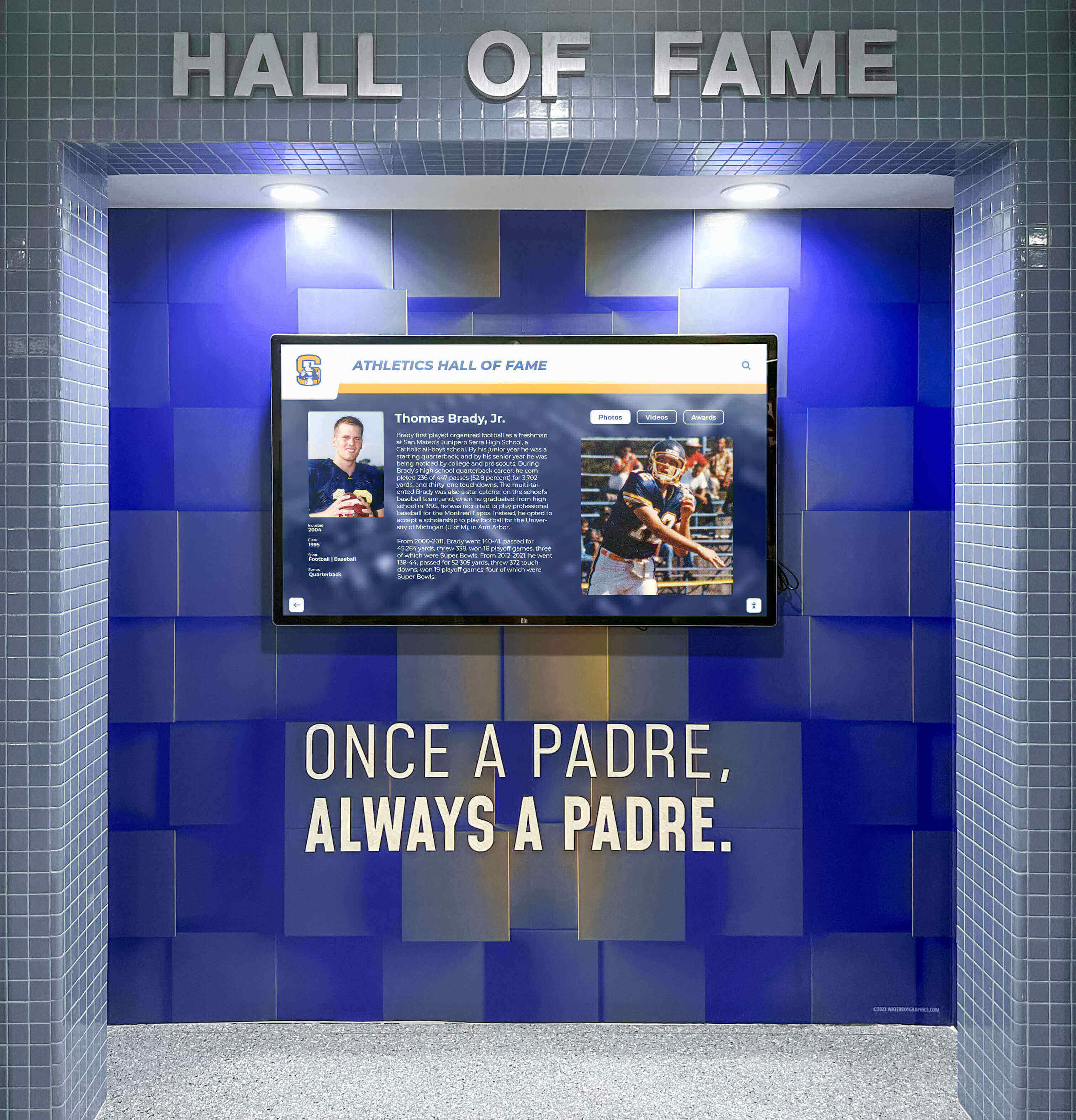Basketball excellence deserves recognition that endures beyond the final buzzer. From legendary professional careers commemorated at the Naismith Memorial Basketball Hall of Fame in Springfield, Massachusetts, to high school athletes breaking scoring records in small-town gymnasiums, basketball achievements represent dedication, skill development, teamwork, and competitive excellence that shape lives and inspire communities. Yet many schools, organizations, and institutions struggle to create recognition systems that adequately honor basketball accomplishments while inspiring future generations of athletes.
Whether you’re an athletic director planning a new basketball recognition program, a school administrator seeking to honor program legends, or a booster club member working to celebrate team achievements, this guide provides actionable strategies for creating meaningful basketball hall of fame experiences that serve your basketball community for generations.
Understanding Basketball Halls of Fame at Every Level
Basketball recognition programs exist across the competitive spectrum, each serving distinct communities while sharing common purposes of honoring achievement and preserving basketball heritage.
The Naismith Memorial Basketball Hall of Fame: Basketball’s Highest Honor
The Naismith Memorial Basketball Hall of Fame, located in Springfield, Massachusetts—where Dr. James Naismith invented basketball in 1891—represents the sport’s most prestigious recognition. This institution honors individuals and teams who have made exceptional contributions to basketball at all levels.
The Hall of Fame inducted its first class in 1959, honoring 17 individuals including the sport’s founder, Dr. Naismith himself. Since then, the Enshrinement Ceremony has become one of basketball’s most celebrated events, typically held each September during Labor Day weekend.
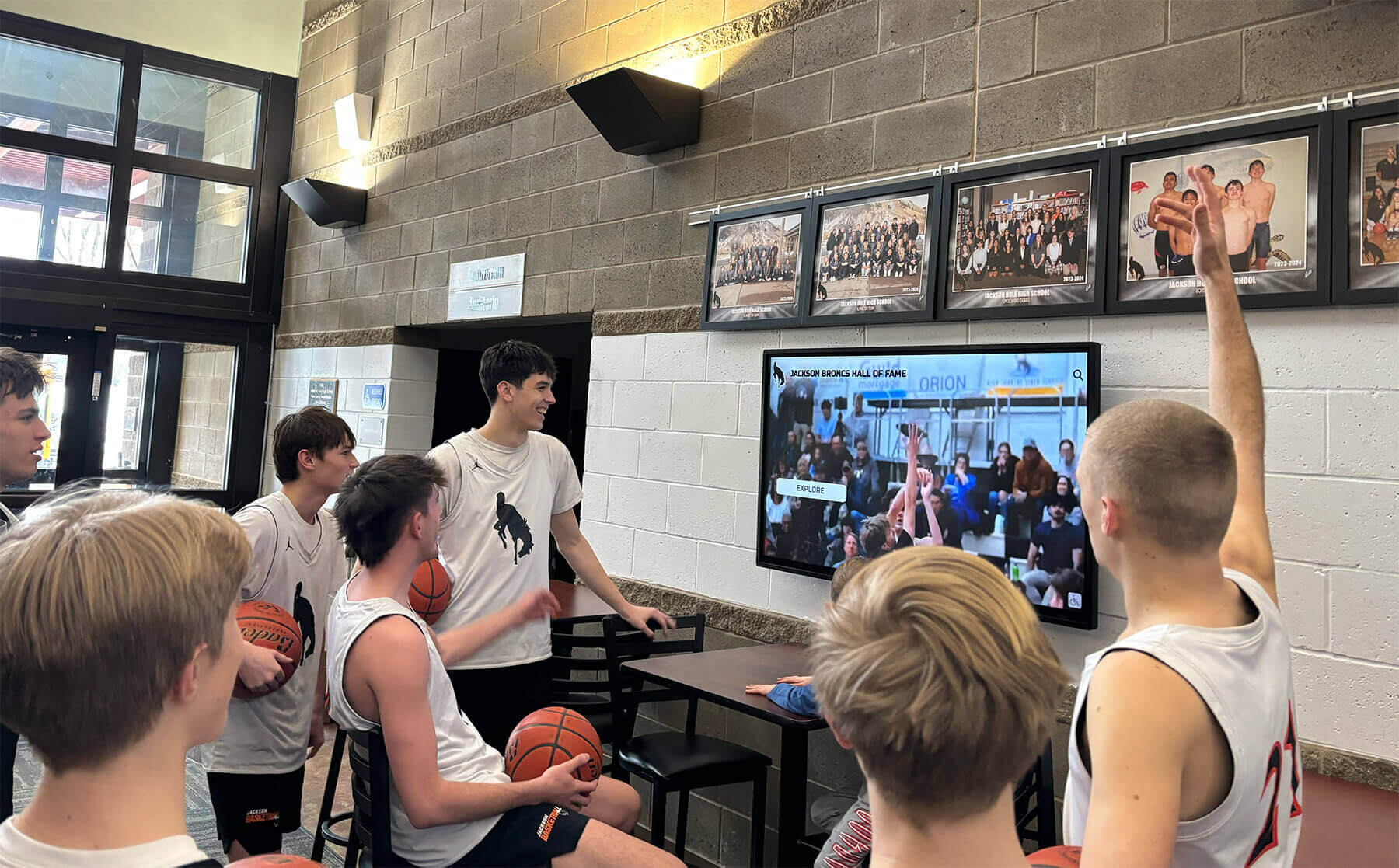
The 2025 class included NBA legends Carmelo Anthony and Dwight Howard, WNBA stars Sue Bird, Maya Moore, and Sylvia Fowles, coach Billy Donovan, and the 2008 U.S. Olympic men’s basketball team dubbed the “Redeem Team.” These inductees joined an elite group representing the pinnacle of basketball achievement.
Selection for the Naismith Memorial Basketball Hall of Fame considers contributions across all basketball levels—professional, collegiate, international, and high school. A North American Committee screens eligible candidates, with election requiring 18 of 24 affirmative votes from the Honors Committee. The rigorous selection process maintains the Hall’s prestige as basketball’s ultimate individual honor.
Professional Basketball Halls of Fame
Beyond the Naismith Memorial Basketball Hall of Fame, several professional leagues and organizations maintain their own recognition programs. The Women’s Basketball Hall of Fame in Knoxville, Tennessee, opened in 1999 to honor women’s basketball achievements specifically. State basketball halls of fame celebrate regional professional and amateur excellence across specific geographic areas.
These specialized halls complement the Naismith Hall by focusing on particular segments of the basketball community, ensuring that women’s basketball pioneers, state legends, and regional contributors receive appropriate recognition even when they may not achieve the national prominence required for Naismith enshrinement.
College Basketball Recognition Programs
College basketball programs create institutional halls of fame honoring exceptional players, coaches, and teams who elevated their programs. These recognition systems celebrate athletes who achieved All-American honors, led teams to conference championships or NCAA tournament success, set program records, or exemplified institutional values while competing.
Most major college basketball programs maintain comprehensive recognition including displays in basketball facilities, online databases of program legends, and annual induction ceremonies during basketball season. Schools like Duke, Kentucky, Kansas, North Carolina, and UCLA—programs with extensive championship traditions—particularly emphasize basketball hall of fame recognition as part of program culture.

College basketball halls of fame serve multiple strategic purposes beyond honoring past achievement. They strengthen recruiting by demonstrating program tradition to prospective student-athletes, create engagement opportunities with alumni who feel valued through recognition, preserve institutional athletic history that might otherwise fade, and inspire current players by showcasing concrete examples of excellence achieved in their program.
High School Basketball Hall of Fame Programs
High school basketball recognition programs honor exceptional athletes, coaches, and teams at the local level where basketball passions often run deepest. State basketball associations frequently maintain statewide halls of fame recognizing the most outstanding contributors to high school basketball within their borders.
Individual schools also create their own basketball halls of fame celebrating program-specific excellence. These local recognition systems might honor 1,000-point scorers, conference or state champions, athletes who earned collegiate scholarships, exceptional coaches with winning traditions, or teams that achieved memorable seasons.
High school basketball halls of fame face unique challenges compared to college or professional recognition. Budget constraints limit investment in elaborate displays, administrative staff time for maintaining programs proves limited, physical space in facilities restricts traditional recognition capacity, and historical records from decades past may be incomplete or scattered.
Despite these challenges, high school basketball recognition delivers tremendous value to programs and communities. Basketball provides identity and pride in many communities, particularly smaller towns where high school sports unite entire populations. Proper recognition of basketball excellence strengthens this community fabric while motivating current athletes and engaging alumni.
Essential Components of Effective Basketball Hall of Fame Programs
Successful basketball recognition systems share common elements that ensure fairness, maintain credibility, and create meaningful experiences for honorees and visitors.
Clear Selection Criteria and Processes
Establishing transparent selection standards prevents perceptions of favoritism while ensuring recognition maintains appropriate prestige. Most basketball hall of fame programs consider multiple achievement dimensions when evaluating candidates.
Athletic Achievement Standards typically form the foundation of selection criteria. For player recognition, consider achievements like career scoring milestones (1,000 or 2,000 points for high school, higher thresholds for college), All-Conference, All-State, All-American, or All-Pro selections, championship team contributions at conference, state, or national levels, statistical records set during careers, and professional basketball career success when applicable.
Coaching recognition might emphasize career wins and winning percentages, championships won at various levels, players developed who achieved higher levels of success, years of service to programs or communities, and innovations or contributions advancing the sport.
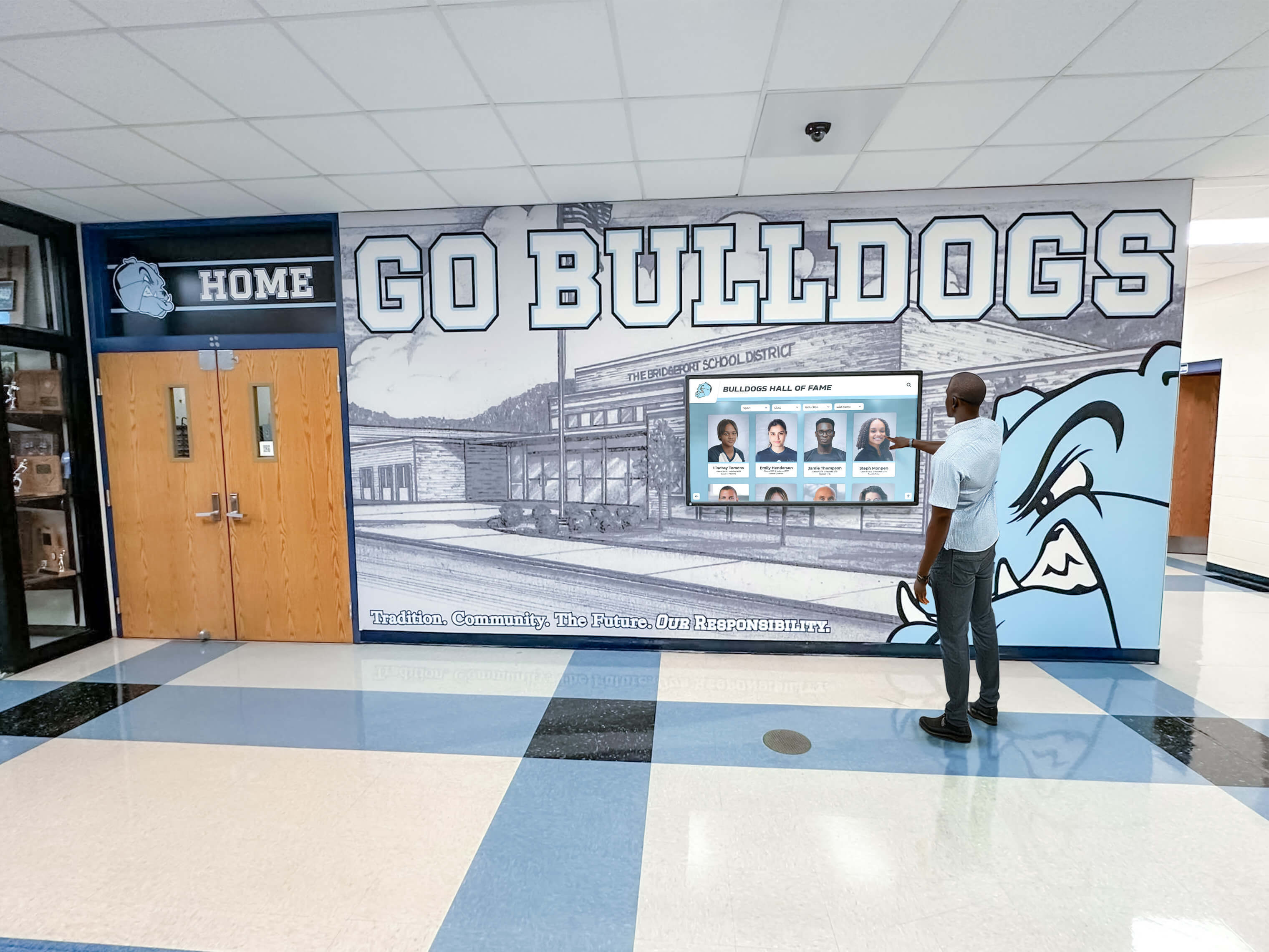
Character and Citizenship Considerations ensure that recognition extends to those who embodied positive values beyond athletic skill. Most programs require that candidates demonstrated sportsmanship and ethical conduct, positive leadership influence on teammates and programs, academic achievement balancing athletic commitments, community service and civic engagement, and representation of institutional or program values.
Some basketball programs have faced difficult decisions when exceptional athletes displayed problematic behavior. Clear criteria help navigate these situations consistently.
Eligibility Requirements manage timing and qualification standards. Common requirements include minimum time periods since graduation or retirement (typically 3-10 years depending on program level), connection to specific institutions, schools, or geographic areas, availability of adequate documentation verifying achievements, and willingness to participate in induction ceremonies or recognition events when possible.
Selection Committee Composition and Process determines who makes final recognition decisions. Effective committees typically include diverse representation from athletic administrators providing institutional perspective, former athletes and coaches understanding achievement context, media members or historians familiar with program heritage, and community representatives ensuring broader stakeholder input.
Most programs use nomination procedures where anyone can submit candidates, followed by committee review against established criteria, voting processes requiring supermajority support for induction, and public announcements celebrating selections. Documenting these processes transparently builds confidence in program integrity.
Comprehensive Induction Ceremonies
The recognition experience matters as much as the recognition itself. Well-planned induction ceremonies create memorable experiences for honorees, families, and basketball communities while generating excitement around hall of fame programs.
Successful ceremonies typically include formal presentations during high-visibility events like halftime of marquee games, speeches from inductees sharing personal reflections and gratitude, testimonials from coaches, teammates, or others familiar with achievements, video tributes showcasing highlights and career moments, presentation of commemorative items like plaques, rings, or certificates, and recognition of family members who supported athletic journeys.
Beyond the ceremony itself, many programs create supporting activities including recognition dinners or receptions for inductees and guests, autograph sessions allowing fans to meet legends, panel discussions where inductees share insights about basketball and life, facility tours showing current program developments, and photo opportunities with championship trophies or displays.
These ceremonial experiences strengthen emotional connections between honorees and institutions while creating shareable moments that extend recognition visibility through media coverage and social sharing. Athletic ceremonies and recognition events create powerful memories that enhance the meaning of induction beyond simply being listed among honorees.
Physical or Digital Displays Creating Lasting Visibility
Recognition ceremonies create memorable moments, but permanent displays ensure that achievements remain visible to current athletes, visitors, and community members year-round. Traditional and modern approaches each offer distinct advantages.
Traditional Physical Displays have served basketball programs for generations. Common formats include wall-mounted plaques listing inductees by year, trophy cases showcasing individual awards and team championships, retired jersey displays for exceptional contributors, and photo galleries featuring team pictures and action shots.
Physical displays provide tangible, always-visible recognition requiring no power or technology, create impressive visual statements in basketball facilities, and convey permanence through substantial materials and professional finishes.
However, traditional approaches face significant limitations in contemporary settings. Physical space constraints eventually limit capacity as programs accumulate honorees across decades, updates and additions require expensive fabrication and installation rather than instant software changes, static formats provide minimal information beyond names and basic achievements, and accessibility limitations mean recognition exists only in single physical locations.
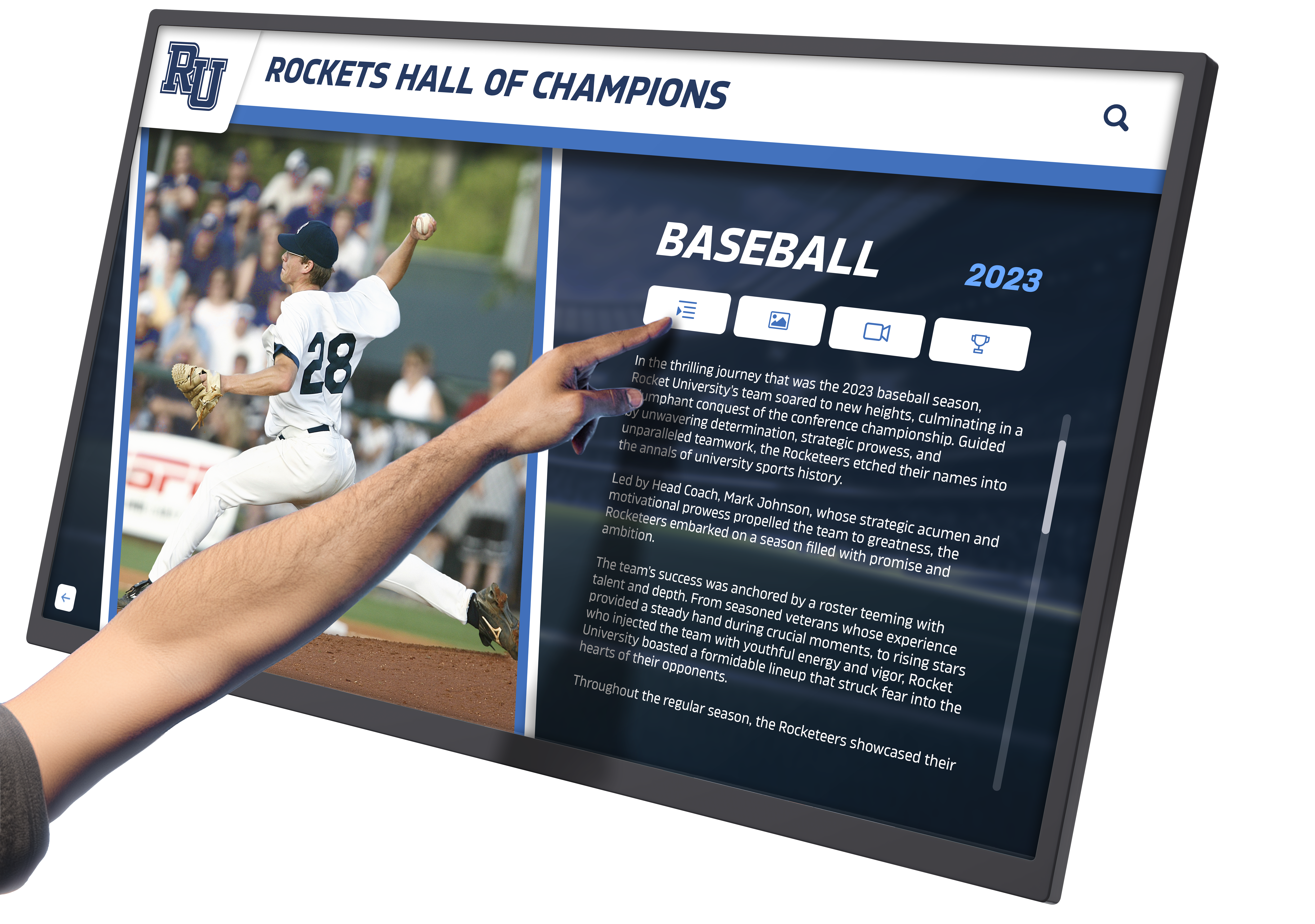
Modern Digital Recognition Systems overcome many traditional limitations while creating enhanced engagement opportunities. Digital hall of fame displays utilize commercial-grade touchscreen technology to create interactive experiences where visitors actively explore athlete profiles, championship teams, coaching histories, and program milestones.
These systems provide unlimited capacity accommodating thousands of honorees without space constraints, instant updates through cloud-based platforms enabling timely recognition, rich multimedia content including photos, videos, statistics, and detailed narratives, searchable databases allowing quick discovery of specific individuals or achievements, and engagement analytics revealing how visitors interact with content.
Solutions like Rocket Alumni Solutions provide purpose-built platforms specifically designed for basketball and athletic recognition, addressing unique needs of sports programs through features including statistical integration, team roster displays, championship season documentation, and sports-specific categorization.
Digital displays prove particularly valuable for basketball programs with extensive histories spanning many decades. Every 1,000-point scorer from the 1960s through today can receive comprehensive recognition rather than only the few whose plaques fit on available wall space. This inclusive approach strengthens alumni connections across broader constituencies while preserving complete program heritage.
Creating High School Basketball Hall of Fame Programs
High school basketball programs form the foundation of America’s basketball culture, developing players who may advance to college or professional levels while creating community pride and school spirit. Establishing effective high school basketball recognition requires addressing unique challenges these programs face.
Establishing Budget-Conscious Recognition Systems
High schools rarely possess athletic budgets comparable to college or professional programs, necessitating creative approaches that maximize recognition value within financial constraints. Several strategies help schools implement meaningful basketball halls of fame despite limited resources.
Phased Implementation Approaches allow programs to begin with modest investment and expand over time. Consider starting with basic recognition of most recent and most legendary figures, with plans to add historical honorees systematically as resources allow, beginning with digital systems holding content even before purchasing display hardware, or implementing recognition in conjunction with facility renovation projects that create natural funding opportunities.
This staged approach demonstrates value before seeking additional investment while preventing budget exhaustion that derails programs before they gain momentum.
Leveraging Booster Clubs and Alumni Support provides funding beyond athletic department allocations. Many programs successfully fund basketball recognition through dedicated fundraising campaigns positioning the hall of fame as a giving opportunity, corporate sponsorships from businesses supporting athletics, memorial gifts honoring deceased community members through recognition displays, alumni donations from former players appreciating recognition, and booster club special projects focused on specific components.
Framing recognition systems as visible, lasting program improvements that benefit current athletes while honoring past achievement resonates with supporters seeking meaningful contribution opportunities. Unlike uniforms or equipment requiring replacement, quality recognition displays provide decades of value from single investments.
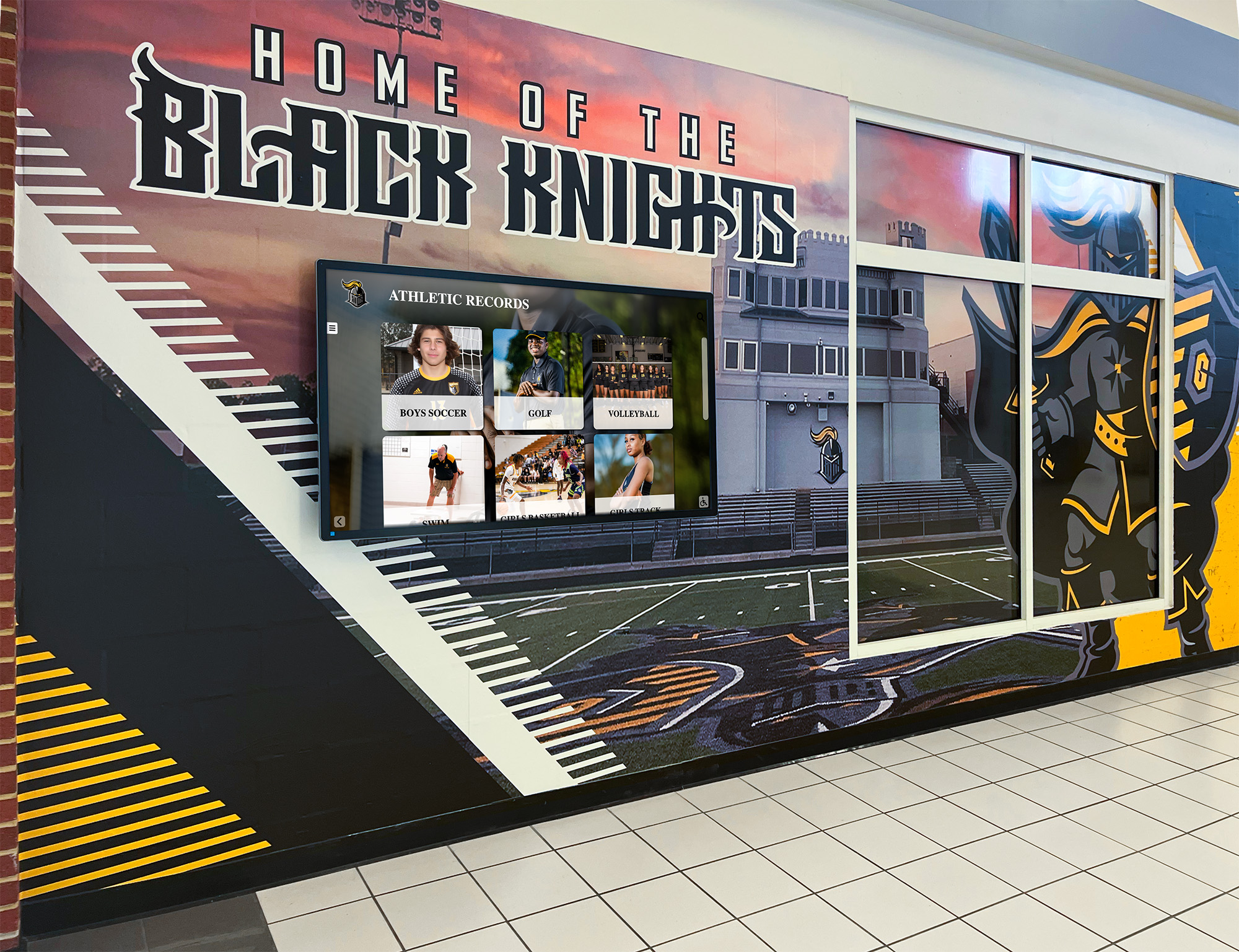
Cost-Effective Digital Solutions democratize comprehensive recognition previously available only to well-funded programs. Entry-level digital recognition systems now start around $8,000-$15,000 for complete installed solutions including hardware, software, mounting, and initial content development. This investment proves comparable to traditional trophy case installations while providing dramatically superior capabilities.
Monthly software costs typically range from $100-$300, often less than schools spend annually updating traditional physical displays. Over typical 5-10 year technology lifecycles, digital systems achieve cost parity with traditional approaches while delivering unlimited capacity, multimedia content, instant updates, and engagement features impossible with physical plaques.
Addressing Historical Records Gaps
Many high schools discover incomplete historical records when attempting to create comprehensive basketball halls of fame. Decades-old achievements may lack documentation, statistics from pre-digital eras exist only in deteriorating paper records, photographs from early program history prove scarce, and oral histories from long-retired coaches or players face fading memories.
Systematic approaches to historical research help schools reconstruct basketball heritage. Productive sources include archived yearbooks from school libraries or alumni collections, local newspaper archives with game coverage and statistics, retired coaches’ personal records and scrapbooks, alumni outreach requesting photographs and memorabilia, state athletic association historical records, and interviews with longtime community members familiar with program history.
Digitizing historical materials serves dual purposes—preserving fragile originals while creating content for recognition displays. Scanning photographs, converting statistical records to digital formats, and recording video interviews with basketball legends creates archival assets supporting recognition while ensuring preservation for future generations.
Some programs successfully engage students in historical research projects, providing educational opportunities in areas like research methodology, interviewing techniques, digital archiving, and local history while advancing hall of fame content development. History classes, journalism programs, and media production courses often embrace these authentic learning opportunities.
Creating Selection Processes Appropriate for School Settings
High school basketball hall of fame selection requires balancing recognition of diverse achievement types while maintaining standards that preserve honor prestige. Unlike professional halls selecting only the sport’s absolute elite, high school programs serve communities where recognition carries local rather than national significance.
Effective high school selection typically considers multiple achievement categories. Individual achievement recognition might honor 1,000-point scorers as the traditional basketball milestone, conference Players of the Year or All-Conference first team selections, state all-star team selections, athletes earning collegiate scholarships to play basketball, and statistical record holders in areas like assists, rebounds, or blocked shots.
Team achievement recognition celebrates conference championship teams, state tournament qualifiers and champions, teams achieving exceptional records like 20+ wins or undefeated seasons, and memorable seasons that elevated programs even without championships.
Coaching recognition honors career milestone achievements like 100, 200, or 300 wins, coaches leading teams to conference or state championships, longevity recognizing sustained program building, and coaches developing players who achieved higher-level success.
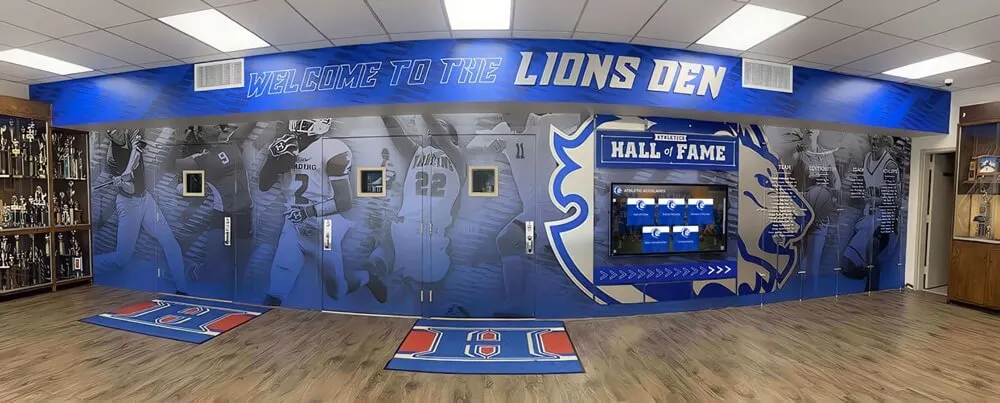
Many high schools create tiered recognition systems—elite honor for exceptional achievers like state champions or multiple all-state selections, significant achievement recognition for conference standouts and 1,000-point scorers, and broad inclusion for all letter winners and program participants. This layered approach celebrates excellence while acknowledging that championship teams require contributions from entire rosters.
Digital platforms make tiered approaches practical by accommodating different content depths for various recognition levels. Legendary figures receive comprehensive multimedia profiles including video highlights and extensive narratives, while solid contributors receive professional recognition with statistics and photographs appropriate to their achievements.
College Basketball Hall of Fame Recognition Programs
College basketball programs combine the competitive intensity approaching professional levels with the institutional tradition and student-athlete experience unique to higher education. College basketball halls of fame reflect these characteristics while serving multiple strategic purposes beyond simple recognition.
Integrating Recognition with Recruiting Strategies
College athletic recruiting depends significantly on program tradition and competitive culture. Comprehensive basketball halls of fame provide tangible evidence of program excellence that influences recruiting decisions when prospects evaluate comparable programs.
During official recruiting visits, coaching staffs strategically incorporate hall of fame displays into facility tours. Prospects encounter names of players who advanced to professional basketball, see documented conference and national championships, discover statistical records showing offensive and defensive standards, and experience physical evidence of program tradition and winning culture.
These displays prove particularly influential when they include athletes from prospects’ hometowns or high schools, creating personal connections. Position-specific recognition helps recruits envision their potential contributions—point guards viewing assist records, post players seeing rebounding achievements, shooters examining three-point milestones.
Digital recognition systems enhance recruiting applications by enabling quick searches for relevant examples during visits. A coaching staff hosting a California recruit can instantly display all program players from California and their achievements. This personalization creates more relevant experiences than static displays presenting information identically to all visitors.
Many programs also leverage online hall of fame platforms during remote recruiting communications. Coaches can share links to specific athlete profiles demonstrating development pathways or championship moments, extending recognition visibility beyond facility visits to homes nationwide.
Supporting Development and Fundraising Initiatives
College athletic departments increasingly rely on philanthropic support for competitive resources. Basketball halls of fame create engagement opportunities that translate into increased giving from athletic alumni constituencies.
Recognition generates emotional connections that inspire financial support. Former players who see achievements honored publicly develop stronger identification with programs and institutions, manifesting through increased giving participation, larger average contributions, and major gift prospects cultivated through recognition-related touchpoints.
Development professionals integrate hall of fame recognition into cultivation strategies by featuring inductees at fundraising events and athletic gatherings, highlighting naming opportunities for recognition components, demonstrating how donor support enabled facilities and resources that produced honored achievements, and creating giving societies with special access to induction ceremonies or exclusive events.

Beyond direct fundraising, engaged basketball alumni provide volunteer support including mentoring current student-athletes in career development, offering internship and employment opportunities, participating in alumni panel discussions and networking events, and serving on athletic advisory boards providing strategic guidance.
The goodwill and engagement generated through thoughtful basketball recognition creates compound value far exceeding recognition program costs. While not all impact proves directly measurable, athletic administrators consistently observe correlation between comprehensive recognition and enhanced alumni involvement across multiple dimensions.
Honoring Women’s Basketball Achievement Equitably
Title IX requirements ensure equitable opportunities for female student-athletes in college athletics. These equity principles extend to recognition and celebration of achievement. Women’s basketball deserves recognition commensurate with its competitive excellence and program contributions.
Effective college basketball halls of fame ensure that selection criteria apply consistently across men’s and women’s programs, selection committees include representatives knowledgeable about both programs, display space and prominence provide equal visibility for both programs, and recognition content provides comparable depth and quality across genders.
Many universities periodically audit hall of fame representation to ensure proportional recognition across men’s and women’s basketball relative to program histories and achievement levels. Systematic attention to equity prevents inadvertent bias while demonstrating institutional commitment to celebrating excellence regardless of gender.
Digital recognition platforms particularly support equity by eliminating space constraints that might force difficult allocation decisions. Both programs receive unlimited capacity for comprehensive recognition rather than competing for finite wall space. This technological advantage helps institutions fulfill both the letter and spirit of equity requirements while honoring all basketball excellence appropriately.
The Basketball Hall of Fame Experience: Visitor Engagement Strategies
Recognition displays should create engaging experiences that inspire visitors, tell compelling basketball stories, and strengthen emotional connections to programs and institutions. Several strategies enhance visitor engagement beyond passive viewing.
Creating Interactive Exploration Opportunities
Traditional static displays require visitors to scan linearly through presented information with limited ability to pursue specific interests. Modern interactive approaches enable personalized exploration creating deeper engagement.
Touchscreen digital systems invite active participation through intuitive interfaces. Visitors can search for specific players, coaches, or teams by name, browse by decade or era to understand program evolution, filter by achievement type such as championship teams or statistical leaders, explore related content through links connecting teammates and coaches, and watch video highlights bringing achievements to life.
This active exploration creates longer engagement sessions as visitors pursue connections and discover unexpected profiles. Analytics from digital platforms consistently show average interaction times of 3-7 minutes compared to seconds for glancing at traditional plaques—an order of magnitude increase in engagement.

Interactive features prove particularly valuable during facility tours when prospective students, recruits, or donors visit. Rather than receiving identical presentations, each visitor can explore content matching their specific interests—hometown connections, particular eras, position-specific achievements, or academic program alignments.
Leveraging Multimedia Storytelling
Statistics and achievement lists provide factual foundations, but compelling narratives create emotional connections that inspire and engage. Multimedia content transforms recognition from documentation into storytelling.
Effective multimedia elements include high-quality action photography capturing athletic moments, formal portraits showing athletes in uniform, video highlights of signature performances and memorable moments, audio interviews where athletes discuss experiences and lessons learned, documentary-style career retrospectives providing comprehensive context, and behind-the-scenes footage showing preparation, training, and team dynamics.
This rich content humanizes achievements and creates personal connections. When visitors watch video of a championship-winning shot while hearing the athlete describe preparation and emotions, they experience the moment rather than simply reading about it. These emotional connections prove particularly powerful for current athletes seeking inspiration and perspective.
Many basketball programs discover that developing multimedia content creates valuable assets useful beyond hall of fame displays. The same videos appear in recruiting presentations, fundraising campaigns, social media content, and documentary projects, multiplying return on content development investment.
Collecting multimedia requires systematic outreach including questionnaires to inductees requesting photographs and materials, video interview sessions during induction ceremonies or dedicated shoots, research through institutional archives and media department records, and coordination with professional teams if athletes advanced to higher levels. The effort invested in comprehensive content development pays ongoing dividends through enhanced engagement and program storytelling.
Providing Context That Educates and Inspires
Recognition becomes more meaningful when visitors understand achievement context. Effective displays provide background helping audiences appreciate significance and historical moment.
Contextual elements might include era-specific information about rules, competition formats, or playing styles, comparative statistics showing how achievements ranked against contemporary standards, narrative descriptions of obstacles overcome or adversity faced, team dynamics explaining individual achievements within collective efforts, and post-graduation impact showing how basketball experiences influenced subsequent lives and careers.
This context proves especially important when honoring athletes from different eras. A 1,000-point scorer from 1965 competed in an era with dramatically different offensive systems, three-point shooting didn’t exist, and seasons included fewer games. Providing context helps modern audiences appreciate achievement rather than simply comparing raw statistics across incomparable circumstances.
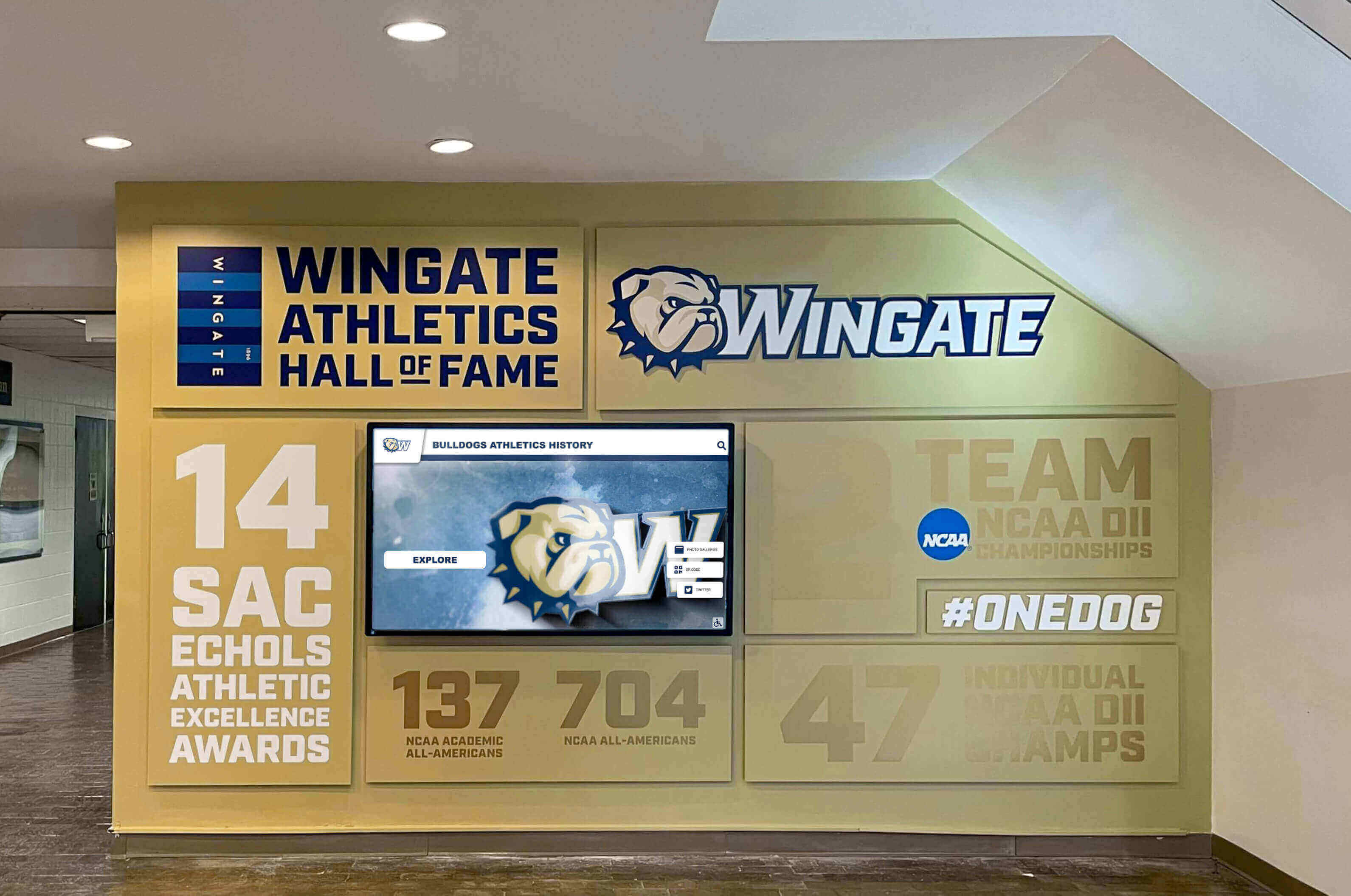
Educational content also enhances recognition for academic audiences. Information about balancing athletic and academic demands, time management strategies, support systems enabling success, and lessons learned through competition resonates with student visitors while reinforcing that athletic achievement occurs within broader educational contexts.
For younger visitors like youth basketball players touring facilities, content emphasizing dedication, practice discipline, teamwork, handling pressure, and perseverance provides motivational lessons applicable to their development regardless of whether they ultimately achieve hall of fame recognition themselves.
Modern Technology Transforming Basketball Recognition
Digital innovation has revolutionized possibilities for honoring basketball achievement while addressing fundamental limitations of traditional physical displays. Understanding available technologies helps programs make informed decisions about recognition investments.
Cloud-Based Content Management Platforms
The software platform fundamentally determines usability and long-term success of digital recognition systems. Purpose-built recognition content management systems provide essential capabilities including intuitive interfaces requiring no coding or technical expertise, responsive design automatically adapting to all screen sizes and orientations, powerful search and filtering for content discovery, multimedia support for photos, videos, audio, and documents, cloud-based architecture enabling updates from any internet-connected device, user permissions and approval workflows managing content governance, analytics tracking engagement and usage patterns, and regular platform updates adding features and maintaining security.
Cloud-based systems eliminate technical infrastructure requirements at institutions. No servers to maintain, no software to install on local computers, and no IT expertise required for operation. Content managers simply log into web-based administration interfaces to add profiles, upload media, update information, and manage all aspects of recognition displays.
This accessibility proves particularly valuable for schools and smaller institutions with limited technical staff. Athletic secretaries, coaches, or dedicated volunteers can manage recognition systems without requiring specialized knowledge, ensuring programs remain current and comprehensive regardless of staffing changes or technical capabilities.
Mobile and Web Access Extending Reach
While physical touchscreen displays create impressive in-facility experiences, extending recognition online multiplies impact and engagement. Web-based companion platforms enable alumni anywhere worldwide to explore basketball hall of fame content from computers or mobile devices, prospective students to research program traditions during remote exploration, families to share athlete profiles through social media channels, media outlets to research historical information for game coverage, and researchers to study program evolution and basketball history.
This digital accessibility transforms recognition from location-dependent physical displays into always-available online resources serving diverse audiences. Alumni living distant from campuses can regularly engage with program heritage, maintaining emotional connections that strengthen giving and engagement.
Many programs implement QR codes at physical displays linking to online platforms where visitors can continue exploration on personal devices, bookmark favorite profiles for future reference, or share content through text messages and social media. This bridge between physical and digital experiences accommodates how modern audiences prefer consuming and sharing content.

Online hall of fame platforms also support integration with broader institutional websites, athletic department communications, and digital marketing initiatives. Recognition content surfaces through search engines, creates linkable resources for media coverage, and provides professional digital presences that reflect positively on programs and institutions.
Data Analytics Informing Continuous Improvement
Digital recognition systems generate valuable usage data revealing how visitors engage with content. Analytics typically track metrics including total interactions and unique visitors over time, average session duration indicating depth of engagement, most-viewed profiles and content revealing audience interests, search query patterns showing what visitors seek, navigation paths demonstrating how users explore content, and demographic information about visitor devices and locations when available.
This data informs strategic decisions about content development priorities—which eras or achievement types deserve enhanced content, what multimedia formats create strongest engagement, and which navigation features prove most valuable to users. Programs can optimize recognition experiences based on actual visitor behavior rather than assumptions.
Analytics also provide concrete evidence of recognition value for stakeholders evaluating programs. Demonstrating thousands of annual interactions, significant engagement duration, and positive usage trends helps justify continued investment while proving community interest in basketball heritage and achievement.
For fundraising purposes, engagement data documents alumni interaction with recognition content, supporting development cases about emotional connections and institutional identification that inspire philanthropic support.
Best Practices from Successful Basketball Hall of Fame Programs
Learning from established recognition programs helps institutions implement effective systems from launch while avoiding common pitfalls that undermine program success.
Starting with Clear Vision and Sustainable Scope
The most common mistake in basketball hall of fame development involves attempting overly ambitious initial implementation that exceeds available resources, creating programs that never reach completion or launch with obvious deficiencies. Successful programs begin with clear, realistic vision matching institutional capacity.
Effective planning addresses fundamental questions including what achievement levels warrant recognition—only the exceptional elite or broader inclusion, what time periods will receive initial focus—recent decades or comprehensive history, what content depth proves appropriate—basic listings or multimedia profiles, what resources are available for initial development and ongoing maintenance, and what timeline allows quality development without rushed execution.
Many successful programs adopt phased approaches—launching with recognition of most recent and most legendary figures, establishing quality standards and processes, then systematically expanding to additional eras and contributors. This staged development maintains momentum while ensuring each phase meets quality standards before advancing.
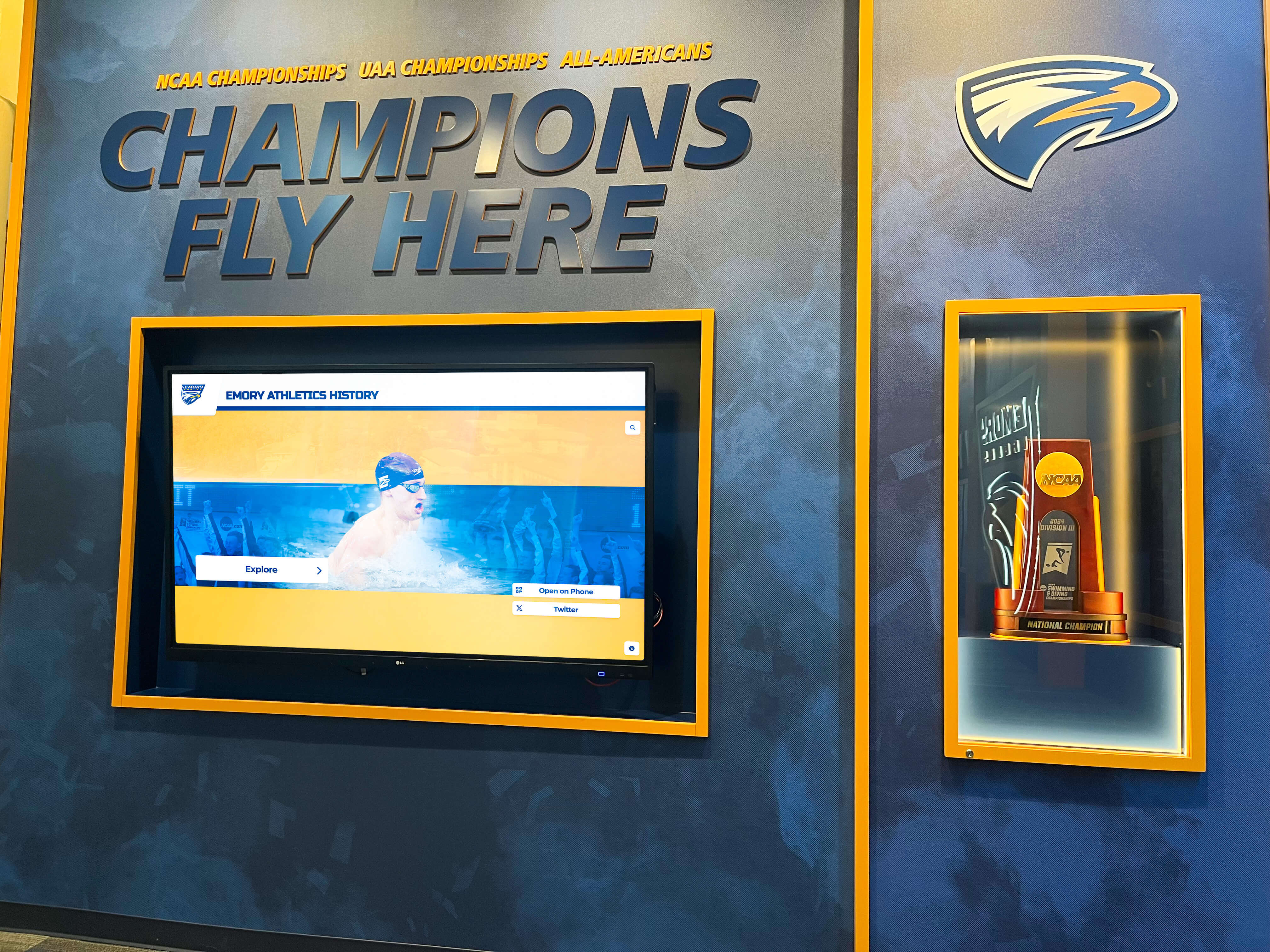
Starting focused and expanding proves more successful than launching ambitiously incomplete programs that undermine credibility through obvious gaps or poor execution. Better to properly honor 50 individuals initially with plans for expansion than inadequately recognize 200 immediately.
Maintaining Consistent Selection Standards
Hall of fame credibility depends on consistent application of selection criteria across all candidates regardless of era, popularity, or external pressure. Once programs establish achievement standards, maintaining them preserves recognition meaning and value.
Pressure to make exceptions inevitably arises—beloved community figures who don’t quite meet athletic achievement standards, influential donors whose playing careers proved modest, or contemporary athletes whose achievements seem impressive until evaluated against historical criteria. Strong selection committees guided by documented standards resist these pressures while explaining decisions transparently.
Some programs create multiple recognition tiers—premier hall of fame for exceptional achievement, broader athletic honor rolls for significant contributions, and comprehensive letter winner recognition for all participants. This tiered structure enables inclusive acknowledgment while reserving highest honor for those meeting rigorous standards.
Documenting selection criteria in writing and applying them consistently across all candidates ensures fairness while simplifying difficult decisions. When standards are clear, committees can evaluate candidates objectively rather than navigating subjective debates that risk perception of favoritism or bias.
Creating Ceremonial Experiences That Honor Inductees
The induction ceremony represents the apex of recognition experience. Well-planned ceremonies create memorable moments for honorees, families, and basketball communities while generating excitement that strengthens program engagement and visibility.
Successful ceremonies balance formality appropriate to honor significance with warmth that creates genuine emotional connection. Elements typically include dignified recognition of each inductee with biographical highlights and achievement summaries, emotional video tributes showcasing career highlights and personal stories, speeches from inductees sharing gratitude and reflections, testimonials from coaches, teammates, or family members, presentation of commemorative items like plaques, rings, or framed certificates, and photo opportunities with existing hall of fame members or program leaders.
Timing ceremonies to maximize attendance proves important. Many programs conduct inductions during homecoming weekends when alumni attendance peaks, halftime of marquee games ensuring large audiences, or dedicated hall of fame banquets creating focused experiences. Each approach offers advantages depending on program goals and community preferences.
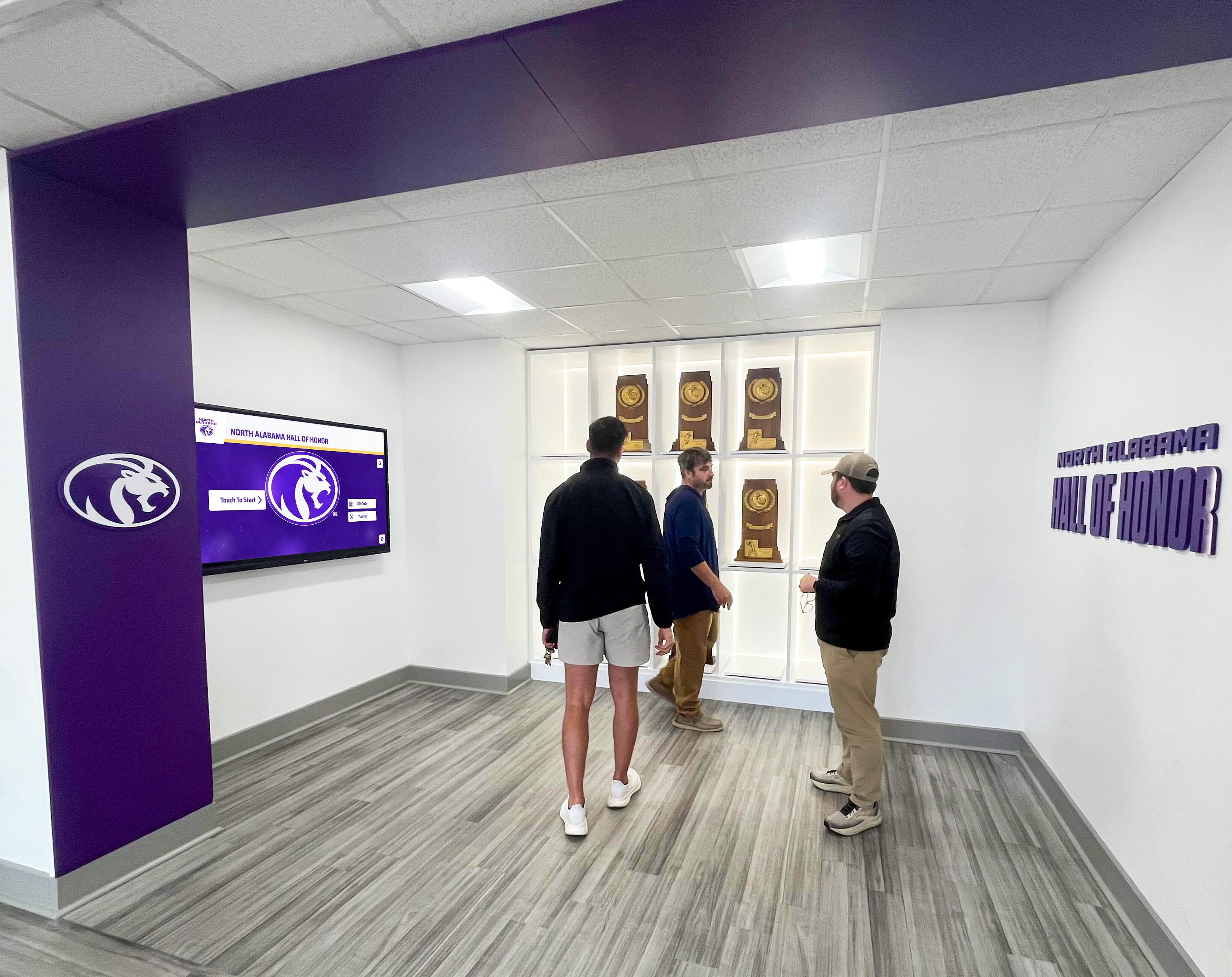
Creating family-friendly ceremonies encourages attendance by spouses, children, and parents who supported athletic careers. Many programs provide reserved seating for inductee families, opportunities for family members to participate in recognition, commemorative programs families keep permanently, and reception opportunities for socializing and celebration following formal ceremonies.
Beyond immediate attendees, extending ceremony reach through live-streaming or video recording, social media coverage and real-time updates, press releases to local media outlets, and highlight compilations shared through digital channels multiplies recognition visibility while creating archival records of ceremonial moments.
Ensuring Ongoing Maintenance and Regular Updates
Recognition programs lose impact when they become static or outdated. Successful programs establish sustainable rhythms for regular additions through annual or biennial induction classes, periodic content enhancements to existing profiles as new information emerges, technology updates maintaining contemporary user experiences, and promotional campaigns keeping recognition visible to target audiences.
Annual induction ceremonies create natural cycles for recognition additions while generating recurring publicity and engagement opportunities. Regular scheduling helps selection committees establish workflows and enables supporters to plan attendance at ceremonies likely occurring during predictable timeframes.
For digital systems, ongoing content enhancement might include collecting additional photographs or video footage for existing profiles, updating inductee information with post-graduation achievements, creating anniversary features highlighting historic moments, and developing new content collections around specific themes or milestones.
Technology maintenance ensures recognition systems remain functional and contemporary. Hardware eventually requires replacement as commercial displays reach end-of-life, software platforms need updates maintaining security and adding features, and user interface designs benefit from periodic refreshes matching evolving aesthetic standards and user expectations.
Assigning clear responsibility for hall of fame management prevents programs from deteriorating through neglect. Whether specific staff positions, dedicated committees, or contracted service providers, successful programs identify who ensures ongoing operations rather than assuming someone will naturally assume responsibility.
Conclusion: Honoring Basketball Excellence for Generations
Basketball achievement deserves recognition that matches its significance. From the legendary players enshrined at the Naismith Memorial Basketball Hall of Fame in Springfield to high school athletes who gave everything to their school programs, basketball excellence represents dedication, skill development, competitive spirit, and personal growth that shape individuals and strengthen communities.
Effective basketball hall of fame programs serve multiple essential purposes. They preserve athletic heritage ensuring extraordinary achievements remain visible to future generations, inspire current athletes by showcasing concrete examples of excellence they can aspire to match, strengthen alumni connections by demonstrating that institutions value athletic contributions, support recruiting by evidencing program tradition and competitive culture, and enhance community pride by celebrating achievement and honoring individuals who represented schools and organizations with distinction.
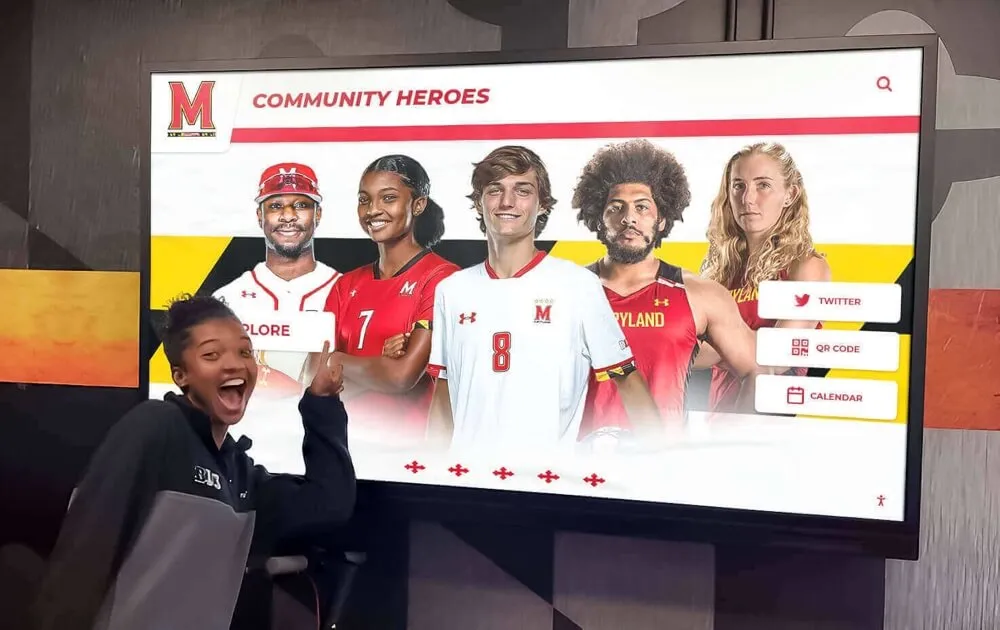
Whether implementing traditional physical displays, modern digital interactive recognition systems, or hybrid approaches combining both elements, successful basketball halls of fame share common characteristics. They establish clear selection criteria applied consistently, create comprehensive content that tells compelling stories beyond basic statistics, maintain accessibility through prominent placement and intuitive organization, provide regular updates keeping recognition current and relevant, and integrate recognition with broader athletic and institutional programming to maximize impact.
The evolution from space-constrained trophy cases to unlimited-capacity digital platforms has fundamentally transformed recognition possibilities. Institutions no longer face impossible choices about which achievements fit limited wall space. Digital solutions enable comprehensive recognition of entire basketball program histories while creating engaging multimedia experiences that resonate with contemporary audiences.
For schools, colleges, and organizations seeking to honor basketball excellence while inspiring future champions, modern recognition technology provides practical approaches that serve communities for generations. From celebrating athletic excellence across all sports to recognizing specific achievement milestones, comprehensive recognition systems deliver lasting value that justifies investment while strengthening programs and institutions.
Ready to explore options for your basketball hall of fame program? Whether starting from scratch or enhancing existing recognition with modern capabilities, solutions like Rocket Alumni Solutions provide specialized support from planning through implementation and ongoing management. Discover how purpose-built recognition technology can transform your institution’s ability to celebrate basketball excellence while inspiring future generations of athletes who will add their own chapters to your program’s legacy.
